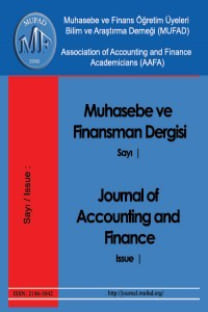Modern Portföy Teorisi Işığında Gerçekleşen Getirilerin Beklenen Getirileri Temsil Gücü
Ampirik çalışmalarda genellikle tarihi/gerçekleşen/geçmiş getiriler (ex post/realized return) beklenen/gelecek getirilerin(expected/ex ante return) tahmincisi olarak kullanılmaktadır. Ancak beklenen getirilerin tahmincisi olarak gerçekleşen getirilerinkullanılması durumunda çoğu zaman teorik finansal modellerin beklenen ampirik sonuçları üretmediği görülmektedir. Örneğin modernportföy teorisi teknikleri ile üretilen portföyler geleneksel portföy yönetim teknikleri ile üretilen portföylere göre daha üstün sonuçlarüretmemektedir. Bu sebeple bu çalışmada gerçekleşen getirinin beklenen getirinin iyi bir tahmincisi olup olmadığı araştırılmıştır. Bunun içinBİST30’da bulunan hisse senetlerinin geçmiş 1, 3 ve 5 yıllık aylık ortalama getirileri ile gelecek bir yılki aylık ortalama getirileriilişkilendirilmiştir. Seçilen geçmiş getiri dönemi kısaldıkça (1 ve 3 yıl için) gerçekleşen ve gelecek getiri arasında negatif yönlü ilişkibulunmuştur (mean reversion). Bu sonuca paralel olarak gerçekleşen getirisi düşük şirketlerin gelecek getirisinin diğer şirketlere göre dahayüksek; gerçekleşen getirisi yüksek şirketlerin gelecek getirisinin diğer şirketlere göre daha düşük olduğu görülmüştür. 5 yıllık geçmiş getiridönemi için ise gerçekleşen ve gelecek getiri arasında pozitif ancak sıfıra oldukça yakın bir ilişki (ilişkisizlik) bulunmuştur. Sonuç olarak 5yıla kadar hesaplanan gerçekleşen getirilerle gelecek getiri arasında pozitif yönlü bir ilişki bulunamamıştır. Bu ise tarihi getirilerin beklenengetirinin iyi bir tahmincisi olmadığına işaret etmektedir. Bu sonuçlar MPT ve CAPM gibi finansal modellerin ampirik testlerinde beklenengetirilerin temsilcisi olarak gerçekleşen getirilerden farklı bir temsilcinin kullanılması gereğine işaret etmektedir.
The Proxy Power of Realized Return for Expected Return in the Modern Portfolio Theory Concept
In the empirical studies, realized (ex post) return are generally used as a estimator/proxy of expected return. However, the theoretical financial models do not produce the expected empirical results in the case of using realized return as an estimator of expected return. For example, portfolios produced with modern portfolio theory techniques do not produce superior results compared to portfolios produced with traditional portfolio management techniques. Therefore,in this study it has been investigated whether the realized return is a good estimator of expected return. For this purpose, we have investigated the relationship between the average monthly realized return for 1,3 and 5 years and the monthly average return for the next 1 year. As the selected ex post return period shortened (for 1 and 3 years), it was found that negative correlation between the realized and ex ante return (mean reverse property). Similarly, it has been saw that companies with low realized return have a high ex ante return and the the companies with high realized return have a low ex ante return. For the 5-year period of ex post return, a relationship,which is positive but very close to zero (unrelatedness), was found between the realized return and ex ante return. In summary, there was no positive correlation between the realized return of 1,3 and 5 years and the ex ante return.This suggests that historical returns are not a good estimator of expected return. These results indicate that alternative proxies for expected return must have used in empirical studies about MPT, CAPM etc.
___
- Bali, Turan G.- Demirtas, K. Ozgur- Levy, Haim (2008) “Nonlinear Mean Reversion in Stock Prices”, Journal of Banking & Finance, Vol. 32(5): pp. 767-782.
- Balvers, Ronald- Wu, Yangru- Gilliland, Erik (2000), “Mean Reversion across National Stock Markets and Parametric Contrarian Investment Strategies”, The Journal of Finance, Vol. 55(2): pp. 745-772.
- Berg, Lennart (2005), “Portfolio Optimisation - Improved Risk-Adjusted Return?”, Department of Economics Uppsala University, Master Thesis.
- Brav, Alon- Lehavy, Reuven- Michaely, Roni (2004), “Using Expectations to Test Asset Pricing Models”, Working Paper, pp: 1-47.
- Chaudhuri, Kausik- Wu, Yangru (2003), “Mean Reversion in Stock Prices: Evidence From Emerging Markets”, Managerial Finance, Vol. 29(10): pp. 22-37.
- Demiguel, Victor (2009), “Optimal Versus Naive Diversification: How Inefficient is the 1/N Portfolio Strategy?”, The Review of Financial Studies, Vol. 22(5): pp. 1916-1953.
- Deniz, Devran- Okuyan, H. Aydın (2018), “Geleneksel ve Modern Portföy Yönetiminin Ampirik Sonuçlarının Karşılaştırılması: Bist Uygulaması”, Mehmet Akif Ersoy Üniversitesi İktisadi ve İdari Bilimler Fakültesi Dergisi, Vol. 5(3): pp. 467-482.
- Elton, Edwin J. (1999), “Expected Return, Realized Return, and Asset Pricing Tests”, The Journal of Finance, Vol. LIV(4): pp. 1199-1220.
- Horimoto, Saburo- Tareq, Mohammad Ali (2013), “The Ex-Ante and Ex-Post Information of an Asset Return”, Seventh International Conference on Innovative Mobile and Internet Services in Ubiquitous Computing: pp. 743-748.
- Karan, Baha (2011), Yatırım Analizi ve Portföy Yönetimi, 3. Baskı, Gazi Kitabevi, Ankara.
- Kim, Myung Jig- Charles R. Nelson- Richard Startz (1991), “Mean Reversion in Stock Prices? A Reappraisal of the Empirical Evidence”, The Review of Economic Studies, Vol. 58(3): pp. 515–528.
- Mora, M. A.- Franco, J.B.- Preciado, L.B. (2010), “Optimal Portfolio Allocation for Latin American Stock Indices”, Cuad. Adm. Bogotá (Colombia) Enero-Junio De , Vol. 23(40): pp. 191-214.
- Mukherji, Sandip (2011), “Are Stock Returns Still Mean-Reverting?”, Review of Financial Economics, Vol. 20: pp. 22-27.
- Tang, Gordon Y. N. (2004), “How Efficient is Naive Portfolio Diversification?” An educational note, Omega, 32(2): pp. 155-160.
- ISSN: 2146-3042
- Yayın Aralığı: 4
- Başlangıç: 2005
- Yayıncı: Muhasebe ve Finansman Öğretim Üyeleri Derneği (MUFAD)
